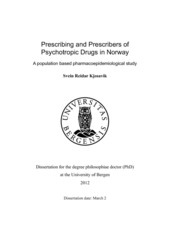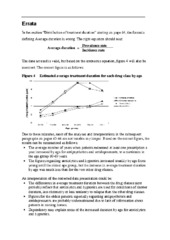| dc.contributor.author | Kjosavik, Svein Reidar | en_US |
| dc.date.accessioned | 2012-04-11T11:10:44Z | |
| dc.date.available | 2012-04-11T11:10:44Z | |
| dc.date.issued | 2012-03-02 | eng |
| dc.identifier.isbn | 978-82-308-1976-0 | en_US |
| dc.identifier.uri | https://hdl.handle.net/1956/5741 | |
| dc.description.abstract | Background One out of three persons in Norway had a mental illness during 2008, and about half of the population will be affected during their lifetime, according to the Government. Although mental health care comprises many other aspects than pharmacotherapy, drugs are widely used to treat psychiatric problems. In this project, the current use of psychotropic drugs in various parts of the health care system is analyzed. No detailed scientific information exists about the relative contribution from different physician groups as regards the prescribing of psychotropic drugs. Aims The main aims of this study were to examine prevalence rates, incidence rates and distribution of psychotropic drug use, i.e. antipsychotics, antidepressants, anxiolytics and hypnotics, with special emphasis on the pattern of prescribing in primary and secondary health care. Material and methods Data on all prescriptions of psychotropic drugs dispensed from all Norwegian pharmacies from 1 January 2004 until 31 August 2009 were extracted from the Norwegian Prescription Database and merged with data about all general practitioners (GPs) in Norway in the same period from the General Practitioner Database, and information about the general Norwegian population from Statistics Norway. Prevalence rates were based on all redeemed prescriptions of these drugs in 2005, while new users of antipsychotics and antidepressants in 2008 or of anxiolytics and hypnotics in 2005 were used to calculate incidence rates. The course of the treatment with anxiolytics and hypnotics was analyzed using a 3.5-year period of follow-up. Results The prevalence rates per 1,000 inhabitants were 153 for any psychotropic drug, or 24 for antipsychotics, 60 for antidepressants, 62 for anxiolytics and 79 for hypnotics (Paper I). The incidence rates were 3.4 for antipsychotics and 8.6 for antidepressants (Paper II), and 18.2 for anxiolytics, 24.5 for hypnotics, or 35.4 per 1,000 for anxiolytics and hypnotics combined (Paper III). Both prevalence rates and incidence rates were higher for women than men, and increased by age. Psychiatrists prescribed an important part of drug treatment to children and adolescents. GPs prescribed the vast majority, but also initiated psychotropic drug treatment to most patients, and the proportion increased by patients’ age. The average treatment duration declined with increased age of the patients in all four drug classes. The duration was longest for hypnotics and anxiolytics, and only every third patient received short-term treatment, as recommended. The total drug volume of anxiolytics and hypnotics redeemed during the first quarter emerged as the strongest predictor of both long-term and heavy use of such drugs. Conclusions Prevalence and incidence rates for psychotropic drug use in Norway are among the highest in Europe. GPs initiate and maintain the drug treatment to the majority. Hence, the quality of psychotropic drug treatment is mainly dependent on the knowledge and practice of each GP. Psychiatrists contribute mainly among children and adolescents and their share of prescriptions decreased significantly with increasing patient age. An increased focus from psychiatrists towards the increasingly ageing part of the population seems requisite. The study confirms that GPs have a key function in the Norwegian health care system, also when it comes to treatment of mental disorders. Improving mental health care is only achieved in a cost effective manner if GPs are a major part of the effort. Implementation of relevant guidelines and systems for structured clinical audit are recommended, especially in general practice. | en_US |
| dc.language.iso | eng | eng |
| dc.publisher | The University of Bergen | eng |
| dc.relation.haspart | Paper I: Kjosavik SR, Ruths S, Hunskaar S. Psychotropic drug use in the Norwegian general population in 2005: data from the Norwegian Prescription Database. Pharmacoepidemiology and Drug Safety 18(7): 572–578, July 2009. Full text not available in BORA due to publisher restrictions. The article is available at: <a href="http://dx.doi.org/10.1002/pds.1756" target="blank"> http://dx.doi.org/10.1002/pds.1756</a> | en_US |
| dc.relation.haspart | Paper II: Kjosavik SR, Hunskaar S, Aarsland D, Ruths S. Initial prescription of antipsychotics and antidepressants in general practice and specialist care in Norway. Acta Psychiatrica Scandinavica 123(6): 459–465, June 2011. Full text not available in BORA due to publisher restrictions. The article is available at: <a href="http://dx.doi.org/10.1111/j.1600-0447.2011.01697.x" target="blank"> http://dx.doi.org/10.1111/j.1600-0447.2011.01697.x</a> | en_US |
| dc.relation.haspart | Paper III: Kjosavik SR, Ruths S, Hunskaar S. Use of addictive anxiolytics and hypnotics in a national cohort of incident users in Norway. European Journal of Clinical Pharmacology 68(3): 311-319, September 2011. Full text not available in BORA due to publisher restrictions. The article is available at: <a href="http://dx.doi.org/10.1007/s00228-011-1124-2" target="blank"> http://dx.doi.org/10.1007/s00228-011-1124-2</a> | en_US |
| dc.title | Prescribing and Prescribers of Psychotropic Drugs in Norway. A population based pharmacoepidemiological study | en_US |
| dc.type | Doctoral thesis | |
| dc.rights.holder | Copyright the author. All rights reserved | |
| dc.subject.nsi | VDP::Medical disciplines: 700::Health sciences: 800::Health service and health administration research: 806 | eng |
| dc.subject.nsi | VDP::Medical disciplines: 700::Basic medical, dental and veterinary science disciplines: 710::Pharmacology: 728 | eng |

